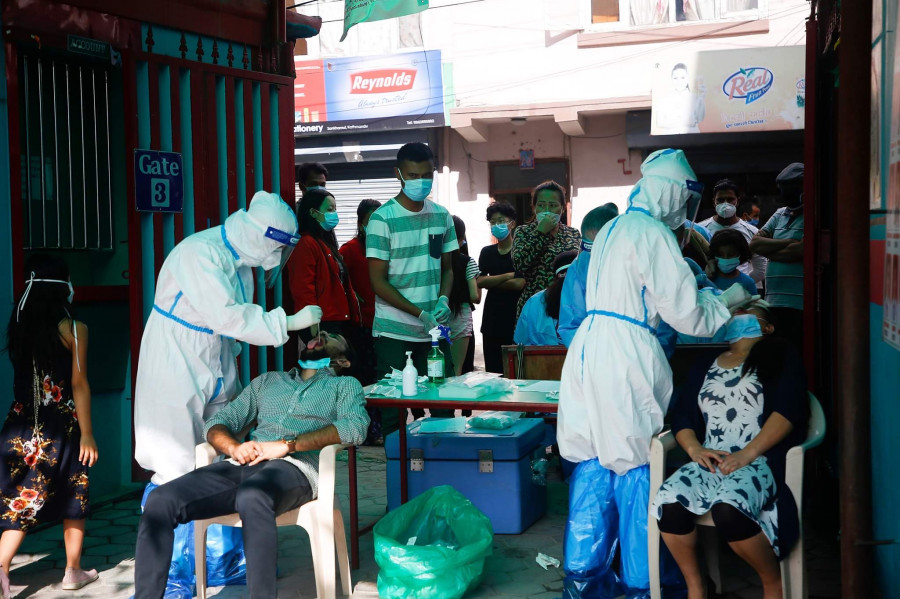Health
Virus is taking hold in community, warn public health experts
With not enough tests being done, infection sources not being traced and 70 percent of the infected in the Valley in home isolation, experts warn of an alarming situation.
Arjun Poudel
A 58-year-old woman from Bhotahiti was among the three people who succumbed to the coronavirus on Monday. She had been taken to Sukraraj Tropical and Infectious Disease Hospital in Teku a couple of weeks ago after she had a mild cough and a fever and difficulty breathing,
The woman was later referred to Patan Hospital for intensive care where she breathed her last.
According to a source at Patan Hospital, the woman had not visited any coronavirus hotspot. Nor had she come in close contact with an infected person. Authorities have not been able to trace the source of her infection as of Monday.
Doctors say unlike in the past days when there were sporadic cases, virus now has penetrated society, and transmission is likely to accelerate.
“People who have never visited disease-hit areas or come in close contact with infected people are not only getting infected but also starting to die,'' Dr Anup Bastola, spokesperson for Sukraraj Tropical and Infectious Disease Hospital, told the Post. “This is evidence that the infection has now taken hold in our community. This is alarming.’’
With the latest deaths announced Monday, the number of people who have died of Covid-19 has reached 107.
According to the Epidemiology and Disease Control Division sources, 235 people tested positive in Kathmandu Valley on Monday, though Dr Jageshwor Gautam, spokesperson for the Ministry of Health, during his daily briefing on Monday put the figure at 168.
Officials at the division said that the data announced in the regular briefing was test results that came in by 2pm, which the division had sent to the Health Ministry.
Gautam said 581 new infections were reported from across the country on Monday, taking the total number of cases to 27,241.
On Sunday, 172 people from the Kathmandu Valley had tested positive for Covid-19.
“Results of the tests we are getting now are the results of the targeted tests. We don’t know the actual situation in vulnerable communities and at-risk groups,” said Bastola. “Number of new cases may be far more than what we are attributing.”
Authorities are only performing tests on those people who have come in close contact with infected persons or on those who have returned from Covid-19 hotspots.
Not all those who seek tests are being tested.
According to officials, 1,000 to 1,200 people visit Sukraraj Tropical and Infectious Disease Hospital to get tested for free, but only 300 are tested on a first come, first served basis, as it lacks human resource and equipment.
Last week Daniel Rai, who works at an IT company in Kathmandu, went for a test at the hospital. But he returned without getting a test done.
“The line at the hospital was too long and social distancing was not being maintained,” said Rai. “I thought I would get infected if I stayed there any longer. So I returned.”
With the government lifting a four-month-long lockdown on July 21, infections of new cases have started to spike throughout the country. In Kathmandu Valley alone 1,752 people have tested positive in the last 27 days. Only 382 people had tested positive until July 21, the day the decision to lift lockdown was taken, in the Valley.
Public health experts said that risk of infection has been rising alarmingly and warned that coronavirus related fatalities may spike if authorities fail to take immediate actions.
‘“We cannot fight the virus, after it is established in the society,” Dr GD Thakur, former director at the Epidemiology and Disease Control Division, told the Post. “Our health system will crash if we fail to act immediately to break the chain of the infection.’’
While there have not been enough tests, contact tracing and availability of isolation beds, the other two bulwarks against the pandemic, have much to be desired.
Kathmandu Metropolitan City did not have enough contact tracing teams till last week before the Health Ministry mandated that each team had to have three trained health workers–a public health official, a lab technician and a paramedic.
Last week the Health Ministry decided to increase the number of staff for contact tracing.
With the lack of isolation beds, people testing positive but without symptoms have been told by the ministry to stay at home.
Officials at the Epidemiology and Disease Control Division said that around 70 percent people who tested positive for coronavirus infection are in home isolation due to the lack of isolation beds in hospitals.
“The only way to contain the spread of infection is to trace more by making contact tracing effective and isolate the patients,” said Thakur. “The public should also be made aware of the looming risks. They should not take risks.’’
With cases starting to spike, the Health Ministry has revised the projection of the total number of cases. Though official projection has not been announced publicly, a source at the Health Ministry said that the cases could cross the 90,000 mark. He did not elaborate on the timeline.
Earlier in June, the ministry had projected 20,000 cases and later revised it to 45,000.
“Cases are growing every day,” said Dr Samir Adhikari, joint spokesperson at the Health Ministry. “The public should be watchful.”




 18.12°C Kathmandu
18.12°C Kathmandu













%20(1).jpg&w=300&height=200)
